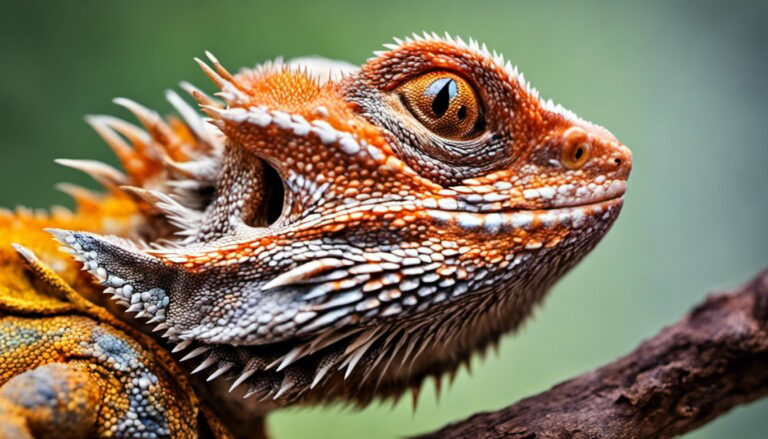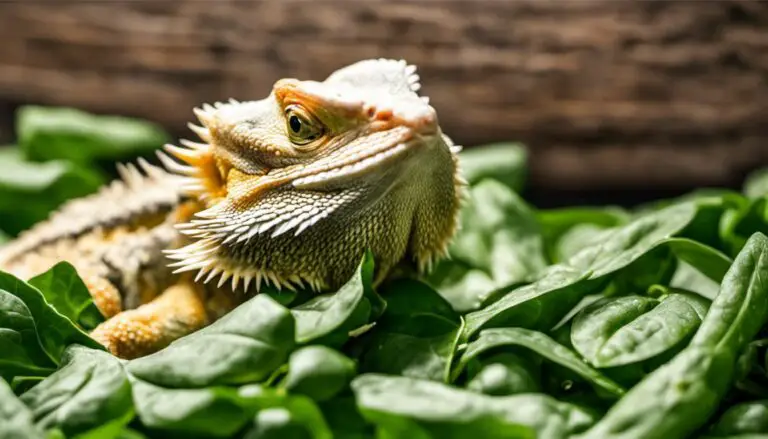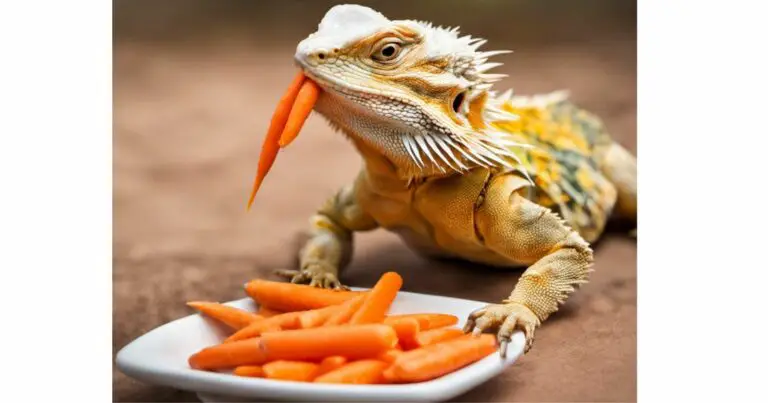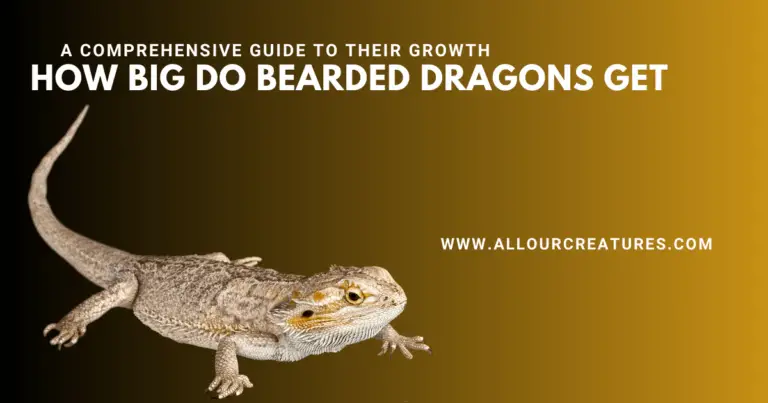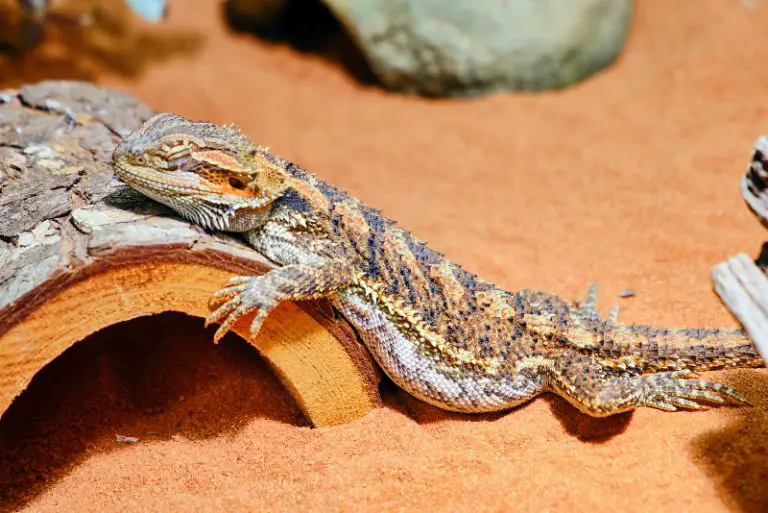What Size Tank for Bearded Dragon: A Comprehensive Guide
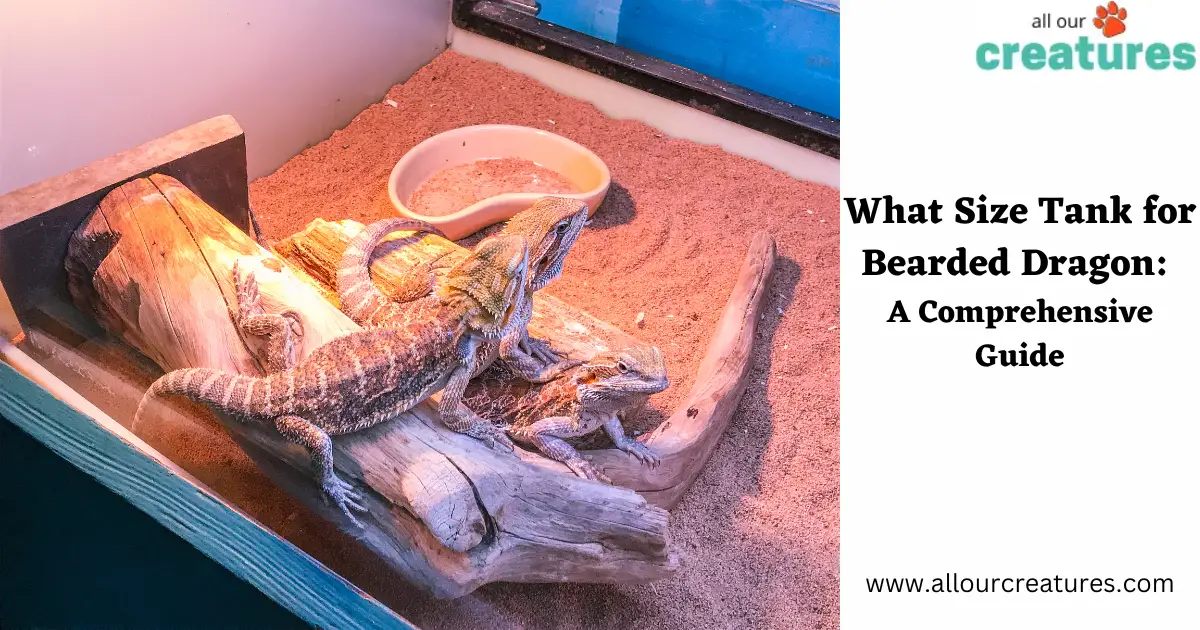
Bearded dragons are popular reptile pets known for their unique appearance and lively personalities. When it comes to housing these fascinating creatures, one of the most critical questions bearded dragon owners ask is, “What Size Tank for Bearded Dragon?” Providing a suitable habitat is vital for the health and well-being of your pet, as it directly impacts their ability to thrive and engage in natural behaviors. Let’s deep dive into the topic.
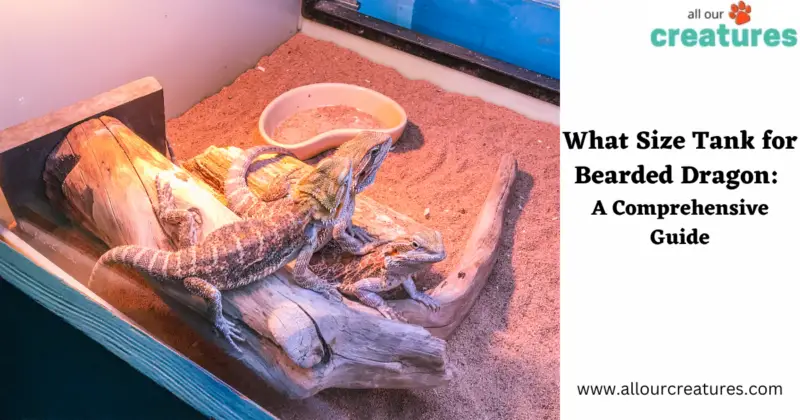
Contents
Table of Contents
Tank Size for Bearded Dragons: Ultimate Guide
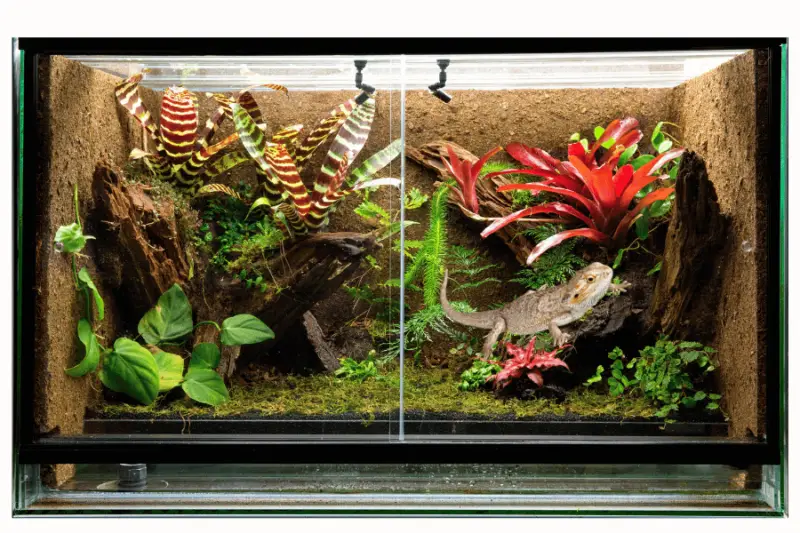
Tank size for bearded dragons varies depending on their age and size. Baby bearded dragons typically require a 20 to 40-gallon tank, as this offers enough space for them to grow and develop the skills needed for catching their food. As they mature, juvenile bearded dragons need a larger enclosure, with a 40-gallon tank being the minimum size recommended. When reaching full adulthood, bearded dragons can grow up to 24 inches in length, and a 120-gallon tank is ideal for them to comfortably carry out their natural behaviors.
To ensure the health and happiness of your bearded dragon, take time to consider and invest in an appropriately-sized tank. This not only promotes their well-being but also contributes to a more enriching and fulfilling life for your scaly companion.
Bearded Dragon Basics
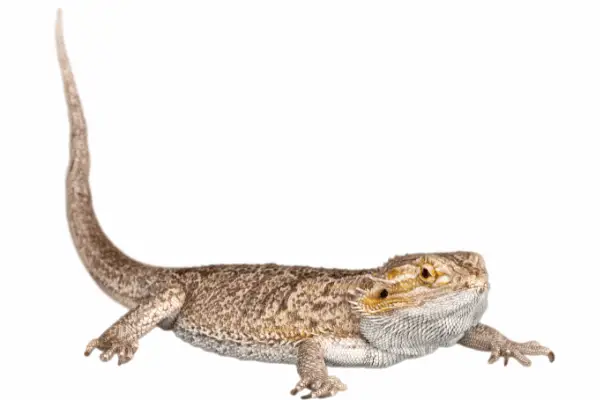
Natural Habitat
Bearded dragons are native to the arid Australian desert regions. They thrive in hot, dry environments with a temperature range of 75-110°F. Generally, bearded dragons inhabit arid woodlands, grasslands, and scrublands.
Adult and Juvenile Sizes
Bearded dragons vary in size depending on their age:
- Baby: up to 12 inches
- Juvenile: up to 15 inches
- Adult: over 15 inches
As they grow, their tank size requirements change as well. For babies, a 20-gallon tank is appropriate, while a 40-gallon tank is needed for juveniles. Adults require a tank between 75 and 125 gallons.
Life Expectancy
With proper care, bearded dragons can live up to 8-12 years in captivity. Key factors in ensuring a long, healthy life for your bearded dragon include providing an appropriate living space, a well-balanced diet, and proper temperature and lighting conditions.
Diet and Food Requirements
A bearded dragon’s diet typically consists of a mix of insects, greens, and vegetables. Some staple insects for their diet include crickets, mealworms, and Dubia roaches. It’s important to provide a variety of vegetables and greens, such as collard greens, mustard greens, squash, and bell peppers.
When feeding your bearded dragon, consider their age and size:
- Baby bearded dragons: 80% insects, 20% vegetables
- Juveniles: 50% insects, 50% vegetables
- Adults: 20% insects, 80% vegetables
Choosing the Right Tank Size

Baby Bearded Dragon
When selecting a tank size for your baby bearded dragon, it’s important to choose one that provides enough space for them to grow and develop, while also allowing them to catch their food easily. A tank of 20-40 gallons is recommended for baby bearded dragons, with dimensions of 36 inches long, 18 inches wide, and 18 inches deep. Providing this amount of space ensures a healthy and happy environment for your baby beardie.
Juvenile Bearded Dragon
As your bearded dragon grows, so should their living space. Juvenile bearded dragons should be housed in a tank of 55-75 gallons, with dimensions of 48″x18″x21″. This larger enclosure allows your juvenile beardie to explore and move around more comfortably, promoting both physical and mental wellbeing.
- Minimum Tank Size: 55 gallons
- Ideal Tank Size: 75 gallons
- Dimensions: 48″x18″x21″
Adult Bearded Dragon
Once your bearded dragon reaches adulthood (usually around 20 inches in length), a tank of at least 40 gallons should be provided, with larger tanks being highly recommended.
A commonly suggested adult bearded dragon tank size is a 50-gallon tank with dimensions of 36″x18″x18″. This size ensures your adult bearded dragon has enough space to move, bask, and generally live a healthy and fulfilling life.
Remember, when considering the tank size for bearded dragons, the most important factor is providing enough space for them as they grow from babies to adults. By choosing the appropriate tank size and adjusting it accordingly as your beardie matures, you’ll ensure a healthy and happy environment for them throughout their lives.
Ideal Tank Setup
Substrate and Material
For a bearded dragon’s tank, selecting the right substrate is essential. Suitable options include newspaper, paper towels, reptile carpet, or a non-adhesive shelf liner. Loose substrates, such as sand or “calcium sand,” could cause impaction if ingested and are best avoided.
Temperature and Humidity Range
Maintaining appropriate temperature and humidity levels is vital for your bearded dragon’s health. The ideal temperature range during the day is 75-85°F (24-29°C) on the cool side and 95-110°F (35-43°C) on the basking spot, with nighttime temperatures dropping to around 70°F (21°C). The optimal humidity level should remain between 30-40%. Keep track of these measurements using thermometers and hygrometers.
Lighting and Heat
Proper lighting and heating are crucial for your bearded dragon’s wellbeing. A combination of UVB lights and heat lamps is necessary. The UVB light assists in calcium absorption and overall health, while the heat lamp provides warmth for basking, digestion, and overall activity. Make sure the UVB light spans the majority of the tank, allowing your bearded dragon access to essential light for at least 10-12 hours a day.
Basking Area
Create a basking area in your bearded dragon’s enclosure, allowing them to warm up and thermoregulate. A raised platform or stack of rocks makes an ideal basking spot, as long as it is stable and secure. Position the heat lamp above the basking area, ensuring proper temperature regulation.
Water and Food Dish
Provide a shallow water dish for your bearded dragon to drink from, placed in a cooler section of the tank. Clean the water dish daily to prevent the growth of bacteria. For feeding, a separate dish containing fresh vegetables and live insects can be offered, as appropriate for your dragon’s age and dietary requirements.
Ventilation and Monitoring
An adequately ventilated enclosure is essential for your bearded dragon’s health. Opt for a tank with a mesh top or ventilation holes to encourage air circulation within the habitat. Regularly monitor the temperature, humidity, and overall condition of the tank to ensure it meets your bearded dragon’s needs.
Decorations and Climbing Structures
Bearded dragons enjoy climbing and exploring, making it important to provide decorations and structures for them to navigate within their tank. Include branches or rocks for climbing, along with hiding spots, such as a hollow log or cave. Ensure these items are secure and do not pose a risk of toppling onto your bearded dragon. Finally, consider internal tank decorations that mimic your dragon’s natural environment, such as plants or desert-inspired decor.
Recognizing Stress Signs in Bearded Dragons
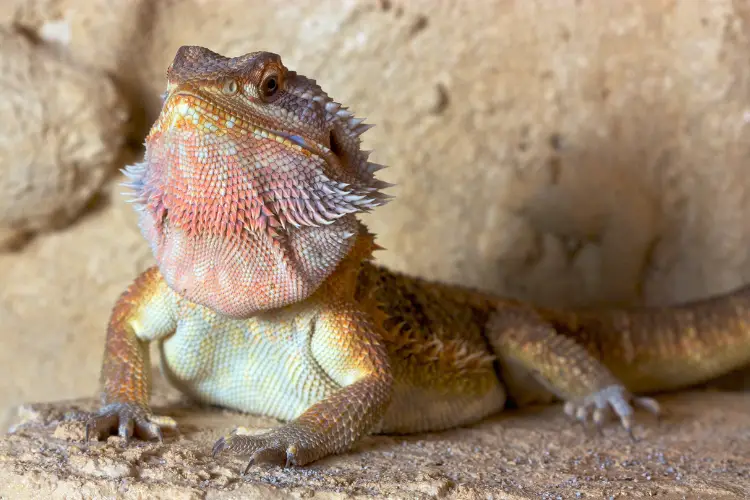
Weather Conditions
Bearded dragons are desert lizards, so maintaining proper temperature and humidity levels in their vivarium is essential for their health and well-being. An environment that is too hot, cold, or humid can induce stress. Make sure your bearded dragon’s enclosure provides adequate basking spots and temperature gradients. Keep the humidity level between 30-40% to mimic their natural desert habitat.
Stunted Growth
Inadequate nutrition and poor husbandry can lead to stunted growth in bearded dragons. A primary cause of such an issue is metabolic bone disease (MBD), a result of inadequate calcium intake or poor calcium absorption due to a lack of UVB light exposure. To prevent stress and MBD, ensure your bearded dragon receives a balanced diet of insects, greens, and supplements, and has access to a high-quality UVB light source.
Health Issues
Health problems like parasites, respiratory infections, or mouth infections can also contribute to stress in bearded dragons. Monitor your pet for signs of illness, such as lethargy, difficulty breathing, or discolored teeth. If you notice any concerning symptoms or changes in your bearded dragon’s health, consult a veterinarian who specializes in reptiles.
Behavioral Changes
Some evident stress signs in bearded dragons include darker coloration, decreased appetite, decreased basking time, glass surfing, or frequent hiding.
Proper enclosure size plays a vital role in reducing stress and promoting healthy behaviors. Bearded dragons require sufficient room to move and explore their environment. For young beardies (0-3 months), a 20-40-gallon tank is suitable. As they grow (4-5 months), their tank should be upgraded to 40-75 gallons.
Providing a well-sized vivarium with safe hiding spots, basking areas, and climbing opportunities mimics their natural habitat and helps to alleviate stress.
Watch The Perfect Bearded Dragon Enclosure Setup for ANY Budget!
Tank Options and Recommendations
Glass Tanks
Glass tanks are a popular choice for bearded dragon enclosures, as they are readily available and often come in standard sizes. A 40-gallon glass tank is the minimum recommended size for juvenile bearded dragons, while adults require at least a 75-gallon tank. Glass enclosures provide good visibility and are easy to clean.
However, they can be quite heavy and may not retain heat as well as other materials. When setting up a glass tank, make sure to include proper heat lamps, UV lighting, and a thermometer to maintain appropriate temperature and humidity levels.
Wooden Tanks
Wooden tanks offer better insulation than glass, making it easier to maintain consistent heat and humidity levels for your bearded dragon. A 120-gallon enclosure made of wood is a suitable option for adult bearded dragons. Wooden tanks can be more customizable, allowing pet owners to create specific conditions for their bearded dragons.
However, wooden enclosures may require more maintenance, as they can be susceptible to rot and moisture damage. Consider installing a hygrometer alongside a thermometer to monitor humidity levels. Don’t forget to provide adequate UV light and heating sources.
PVC Enclosures
PVC enclosures are a lightweight and durable option for bearded dragons. They typically come in a variety of sizes, including the 40-gallon and 120-gallon options. Due to the PVC material’s insulating properties, these enclosures maintain consistent heat and humidity levels more effectively than glass or wood.
PVC enclosures are also stain-resistant and simple to clean. It’s essential to include proper heating, UV lighting, and monitoring devices like thermometers and hygrometers in a PVC enclosure.
In summary:
| Enclosure Type | Pros | Cons |
|---|---|---|
| Glass | Good visibility, easy to clean | Heavy, less heat retention |
| Wood | Better insulation, customizable | More maintenance required |
| PVC | Lightweight, durable, heat retention | Slightly more expensive |
When selecting a tank for your bearded dragon, consider factors like size, material, and your dragon’s needs. Regardless of the enclosure type, make sure to include heat lamps, UV lights, a basking rock, and monitoring devices to ensure your bearded dragon enjoys a suitable and comfortable environment.
Caring for Your Bearded Dragon
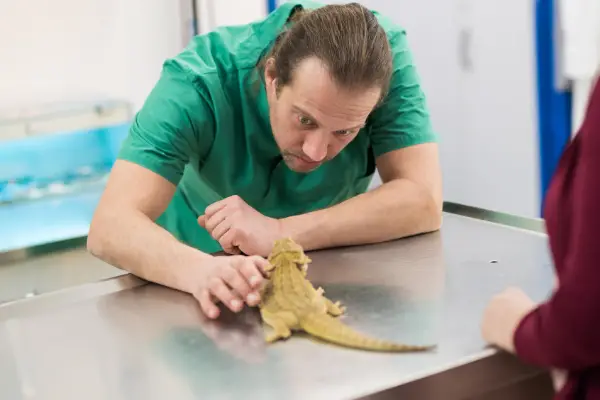
In this section, we’ll discuss the essentials of caring for your pet bearded dragon. The three main areas include Proper Diet, Lighting and Heat Requirements, and Enclosure Maintenance. By paying close attention to these elements, you can ensure a happy and healthy environment for your beardie.
Proper Diet
A balanced diet is essential for a bearded dragon’s overall health. This should include a mix of greens, vegetables, fruits, and protein sources such as insects. Here’s a recommended food breakdown for a bearded dragon:
- 80-90% vegetables and greens: kale, collard greens, mustard greens, etc.
- 10-20% fruits: blueberries, raspberries, apples, etc.
- Protein: crickets, roaches, mealworms, or superworms (dusted with calcium powder)
Feed your bearded dragon daily, adjusting the portion size to the age and size of your dragon. Juvenile dragons require more insects for protein and a higher calcium intake. In contrast, adults thrive on a mostly plant-based diet with insects and protein sources offered less frequently.
Lighting and Heat Requirements
As ectotherms, bearded dragons require proper lighting and temperature ranges for their enclosure. This includes a basking area, a cool area, and the right balance of UVB lighting to maintain their bodily functions.
Temperature ranges should be:
- Basking area: 95-110°F (35-43°C)
- Cool area: 75-85°F (24-29°C)
To control temperature, use a heat lamp in the basking area and a UVB light to stimulate vitamin D3 synthesis, which promotes calcium absorption and overall health. A temperature gradient within the enclosure helps them regulate their body temperature according to their needs.
Enclosure Maintenance
Keeping your bearded dragon’s enclosure clean and well-maintained is crucial for preventing illness and ensuring a comfortable environment.
- Substrate: Choose a lightweight, easy-to-clean substrate like newspaper or reptile carpet, which is easy to replace when needed.
- Furniture: Rocks, logs, and branches provide a secure environment for your bearded dragon to explore and climb. Be cautious when selecting materials; wooden items should be treated to prevent rot, and rocks should have smooth surfaces to avoid injuries.
- Maintenance: Regularly clean the enclosure and sanitize furniture items. Keep an eye on the humidity level in the tank — bearded dragons prefer a relatively low humidity of around 30-40%.
By addressing these essential aspects of bearded dragon care, you’ll ensure that your pet lives a healthy and comfortable life in his or her tank. Keep it brief, and remember that caring for your bearded dragon is an ongoing process. Enjoy your time together and continue to learn about their needs and preferences to provide the best care possible.
FAQs: What Size Tank for Bearded Dragon

Q: What size tank should I get for my bearded dragon?
A: It is recommended to provide a tank or enclosure that is at least 40 gallons for a juvenile bearded dragon. As they grow, they will eventually need a larger tank, ideally around 75 to 120 gallons for an adult bearded dragon.
Q: Can I start with a smaller tank and upgrade later?
A: While it’s possible to start with a smaller tank for a juvenile bearded dragon, it’s best to plan for the larger tank from the beginning. Frequent tank upgrades can cause stress to your pet, so providing an adequate-sized enclosure from the start is preferable.
Q: What are the dimensions for an appropriate bearded dragon tank?
A: For a standard 40-gallon tank, the dimensions are typically around 36 inches long, 18 inches wide, and 18 inches tall. However, larger tanks with more spacious dimensions are recommended for adult bearded dragons.
Q: Are there any specific tank requirements for bearded dragons?
A: In addition to the size, it’s important to provide a tank with secure ventilation, a sturdy lid or screen top to prevent escapes, and a temperature gradient to allow for thermoregulation. The tank should also have appropriate lighting, substrate, and enrichments.
Q: Can I keep multiple bearded dragons in the same tank?
A: It’s generally not recommended to house multiple adult bearded dragons in the same tank, as they can become territorial and aggressive towards each other. It’s best to provide separate enclosures for multiple adult dragons, while juveniles can sometimes be housed together temporarily under close supervision.

